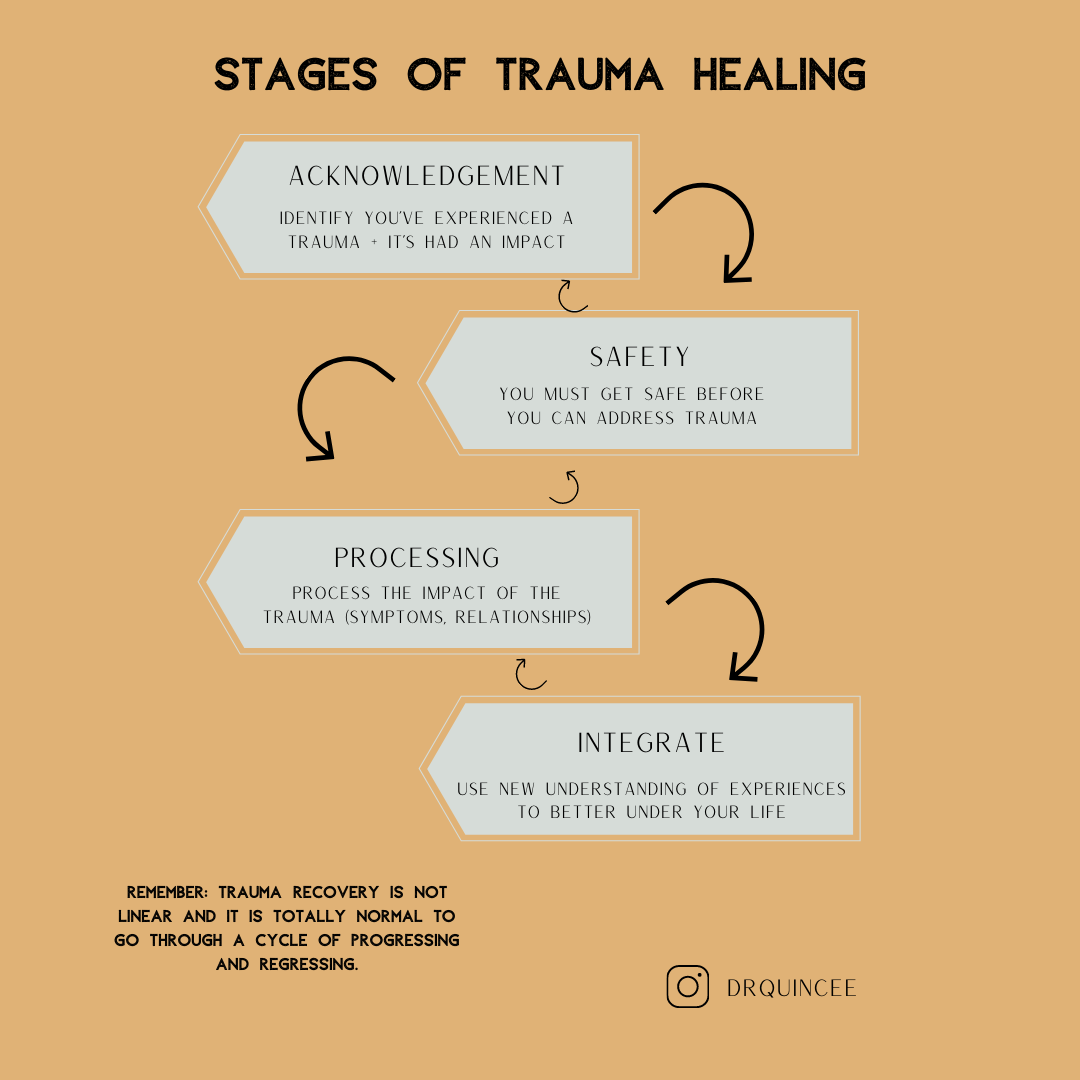Four Stages of Trauma Recovery and Healing
The most common questions we are asked in the world of trauma recovery are: What is the exact process? and How will I know I’m doing the “work” to recover from my traumatic past?
These questions are really understandable because the process of recovering from trauma is difficult to predict and it's often non-linear. I am going to outline the four stages I move each of my patients through in their trauma recovery. Each of these stages have a lot of flexibility within them. That means, even though a person might be in one stage, they might temporarily move back to a previous stage while regaining their footing. Then they continue proceeding through the process.
Before we jump into each of these stages, a gentle reminder: no one’s process of trauma recovery is identical. Each individual’s process is a personal and nuanced experience that has some of these features. This outline is meant to help inform you of where you are in your recovery process, and should never be used to beat yourself up for “failing” or because your process looks different.
The problem?
During trauma recovery, it can feel like you’re in a never ending, confusing process of progressing and then regressing. That is totally normal. But, I also have some good news: Trauma healing happens in big stages. There can be a lot of small ups and downs within these stages, but healing generally unfolds in this way:
Acknowledgement:
Acknowledgement is the process of figuring out if your experience was actually traumatic. Believe it or not, most people deeply mistrust their own perceptions after trauma leaving them to question whether they have accurately identified their experience as “traumatic.” There’s often a period of seeking out information online, taking courses, hearing experiences from others, and exploring these ideas in therapy before being able to identify the experience as traumatic.
People can stay in this stage for a long time while they figure out what happened to them and determine if it was actually traumatic. The Acknowledgement Stage is a process of becoming informed and surviving your current life circumstances, while life increasingly feels more difficult.
Safety:
Safety is perhaps the most difficult part of the trauma recovery process. If you do not feel safe in your body, environment, or relationships, then you will not be able to healthily process the trauma experience(s). Let me repeat this because it is so important: you cannot process your traumatic experiences until you feel safe enough to proceed.
In this stage, focus on creating safety in all aspects of life. The goal is never to guarantee perfect safety because that’s not actually attainable. Focus on creating sufficient safety that allows you to relax enough to trust the therapeutic process.
In therapy, we seek to create safety in:
➕ Relationships
➕ Your body
➕ Your mind
➕ Your environment (home, work, commute, etc.)
It’s also important to remember that you might work very hard to feel safe and yet it will still feel hard to process the trauma. The hope is that you feel safe enough to slowly process the trauma, while also feeling comfortable enough with your therapist to express the limits of your internal sense of safety. A trained professional will help you return to safety psychologically and make sense of what triggered you.
Process:
Once you’ve practiced feeling safe within yourself, your relationships, and your environments, you are ready to start the process of making sense of your response to trauma. In the processing stage, the goal is not: “feel better about the trauma.” Trauma is unjust, unthinkable, and upsetting at its core. So, as therapists, we are never trying to make someone feel good about the trauma they experienced a trauma. The hope is to help you make peace with the ways your mind and body jumped in to help you survive a trauma.
This process is truly meant to be done under the guidance of competent and trained professional support. This can be a triggering, tender, emotionally overwhelming, and panicky time of your recovery. Having someone that knows the ropes of trauma recovery is the most important part of ensuring you are safe and in competent hands while processing.
A gentle reminder about this stage: the recovery will take as long as it takes. There is no stopwatch on this season and it might take longer than you imagine. Give yourself grace and compassion while processing your trauma.
Integrate:
Once you have processed your trauma, you can begin to integrate it into a greater understanding of yourself, your value, and your life's narrative. This is the lighter process of trauma recovery, where you are able to make sense of your trauma response, show yourself unending compassion, and integrate that into your new vision or life goals.
At Woven, we are a practice that specializes in trauma treatment. If you live in the state of California and want professional support in your trauma recovery, you can book a free 30-minute consultation with our warm therapist matchmaker. All of our therapists specialize in trauma-informed care, and informed trauma therapy
Don’t wait on your healing. We are here to help. Booke your free 30-minute consultation
We also offer EMDR therapy, Ketamine Assisted Psychotherapy, and Brainspotting therapy which all have shown to be extremely effective in treating and healing trauma. Want to read more about our unique therapy options?
These blogs talk more about the basics of EMDR therapy:
You can read more about Ketamine Assisted Psychotherapy here:
If you would like to learn more about Brainspotting therapy, check out our blog: What is Brainspotting?


















